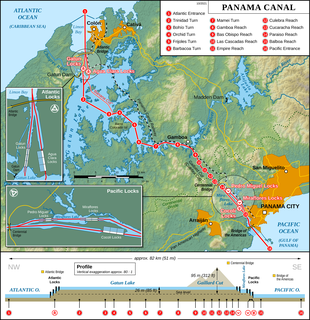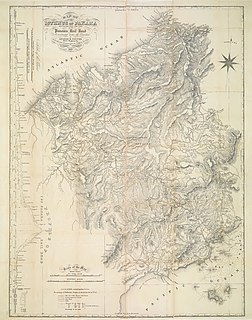
Panama, officially the Republic of Panama, is a transcontinental country in Central America and South America, bordered by Costa Rica to the west, Colombia to the southeast, the Caribbean Sea to the north, and the Pacific Ocean to the south. Its capital and largest city is Panama City, whose metropolitan area is home to nearly half the country's 4 million people.

The history of Panama includes the long history of the Isthmus of Panama region prior to European colonization, from Pre-Columbian cultures, through the Spanish colonial era, and eventual independence as the modern country of Panama.

The Panama Canal is an artificial 82 km (51 mi) waterway in Panama that connects the Atlantic Ocean with the Pacific Ocean and divides North and South America. The canal cuts across the Isthmus of Panama and is a conduit for maritime trade. One of the largest and most difficult engineering projects ever undertaken, the Panama Canal shortcut greatly reduces the time for ships to travel between the Atlantic and Pacific oceans, enabling them to avoid the lengthy, hazardous Cape Horn route around the southernmost tip of South America via the Drake Passage or Strait of Magellan and the even less popular route through the Arctic Archipelago and the Bering Strait.

The Hay–Herrán Treaty was a treaty signed on January 22, 1903, between United States Secretary of State John M. Hay of the United States and Tomás Herrán of Colombia. Had it been ratified, it would have allowed the United States a renewable lease of 100 years on a six-mile-wide strip across the isthmus of Panama for $10 million and an annual payment of $250,000, both payments being in gold coin. It was ratified by the United States Senate on March 14, but it was not ratified by the Senate of Colombia, so it had no effect.

The Hay–Bunau-Varilla Treaty was a treaty signed on November 18, 1903, by the United States and Panama, which established the Panama Canal Zone and the subsequent construction of the Panama Canal. It was named after its two primary negotiators, Philippe-Jean Bunau-Varilla, the French diplomatic representative of Panama, and United States Secretary of State John Hay.

George Washington Goethals was a United States Army General and civil engineer, best known for his administration and supervision of the construction and the opening of the Panama Canal. He was the State Engineer of New Jersey and the Acting Quartermaster General of the United States Army.

The Panama Canal Zone, also simply known as the Canal Zone, was an unincorporated territory of the United States, located in Isthmus of Panama in Central America, that existed from 1903 to 1979. It was located within the territory of Panama, consisting of the Panama Canal and an area generally extending 5 miles (8.0 km) on each side of the centerline, but excluding Panama City and Colón. Its capital was Balboa. Panama Canal Zone was created on November 18, 1903 from the territory of Panama. It was established with the signing of the Hay–Bunau-Varilla Treaty, which allowed for the construction of the Panama Canal within the territory by the United States. It existed until October 1, 1979 when it was incorporated back into Panama.

The flag of Panama was made by María de la Ossa de Amador and was officially adopted by the "ley 48 de 1925". The Panamanian flag day is celebrated on November 4, one day after Panamanian separation from Colombia, and is one of a series of holidays celebrated in November known as the Fiestas Patrias.

The Torrijos–Carter Treaties are two treaties signed by the United States and Panama in Washington, D.C. on September 7, 1977, which superseded the Hay–Bunau-Varilla Treaty of 1903. The treaties guaranteed that Panama would gain control of the Panama Canal after 1999, ending the control of the canal that the U.S. had exercised since 1903. The treaties are named after the two signatories, U.S. president Jimmy Carter and the Commander of Panama's National Guard, General Omar Torrijos.

Philippe-Jean Bunau-Varilla was a French engineer and soldier. With the assistance of American lobbyist and lawyer William Nelson Cromwell, Bunau-Varilla greatly influenced Washington's decision concerning the construction site for the Panama Canal. He also worked closely with President Theodore Roosevelt in the latter's orchestration of the Panamanian Revolution.

William Nelson Cromwell was an American attorney active in promotion of the Panama Canal and other major ventures especially in cooperation with Philippe Bunau-Varilla.

The idea of the Panama Canal dates back to 1513, when Vasco Núñez de Balboa first crossed the isthmus of Panama. The narrow land bridge between North and South America was a fine location to dig a water passage between the Atlantic and Pacific Oceans. The earliest European colonists recognized this, and several proposals for a canal were made.

McPherson (2002) describes the controversial Panama Canal fence as a "separation barrier built by the United States in the Panama Canal Zone that divided the Republic of Panama in two separate sections". The Canal Zone, primarily consisting of the Panama Canal, was a strip of land running from the Pacific Ocean to the Caribbean. The fence, also called “Fence of Shame” and "another Berlin Wall” portrayed the centre of geopolitical and diplomatic turmoil between the United States and the Republic of Panama. Some evidences suggest construction, breaking and repairs of the fence while others including many aerial photographs and Life magazine confirm that there was no such physical barrier between the Canal Zone and Panama.
The Remon–Eisenhower Treaty, was a 1955 treaty between the United States and Panama that updated and amended the original Hay–Bunau-Varilla Treaty of 1903 for the Panama Canal and Panama Canal Zone. Other aspects of the treaty covered local trader / worker rights, upgrades and military base usage.

The separation of Panama from Colombia was formalized on 3 November 1903, with the establishment of the Republic of Panama. From the Independence of Panama from Spain in 1821, Panama had simultaneously declared independence from Spain and joined itself to the confederation of Gran Colombia through the Independence Act of Panama. Panama was always tenuously connected to the rest of the country to the south, owing to its remoteness from the government in Bogotá and lack of a practical overland connection to the rest of Gran Colombia. In 1840–41, a short-lived independent republic was established under Tomás de Herrera. After rejoining Colombia following a 13-month independence, it remained a province which saw frequent rebellious flare-ups, notably the Panama crisis of 1885, which saw the intervention of the United States Navy, and a reaction by the Chilean Navy.

Panama and the United States cooperate in promoting economic, political, security, and social development through international agencies.

There is a long history of attempts to build a canal across Nicaragua to connect the Atlantic Ocean with the Pacific Ocean. Construction of such a shipping route—using the San Juan River as an access route to Lake Nicaragua—was first proposed in the early colonial era. Napoleon III wrote an article about its feasibility in the middle of the 19th century. The United States abandoned plans to construct a waterway in Nicaragua in the early 20th century after it purchased the French interests in the Panama Canal. The Panama Canal was built and that is now the main connecting route across Central America.
The Isthmian Canal Commission was a commission created by congress in 1899 "to determine the most feasible and practicable route" in Central America to build a canal. The commission was chaired by John G. Walker, even though he chaired another congressional commission called the Nicaragua Canal Commission, which had not yet issued its final report, which was released in mid-1899 and, true to its name, recommended the locale of Nicaragua for the construction of a canal. This change of focus was a triumph for the lobbyist William Nelson Cromwell, who was hired by French interests wanting to get rid of the assets of the failed enterprise of Ferdinand de Lesseps.















